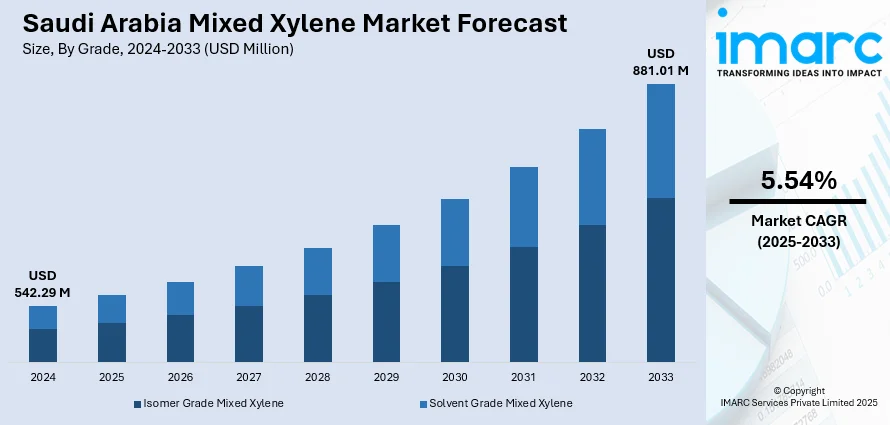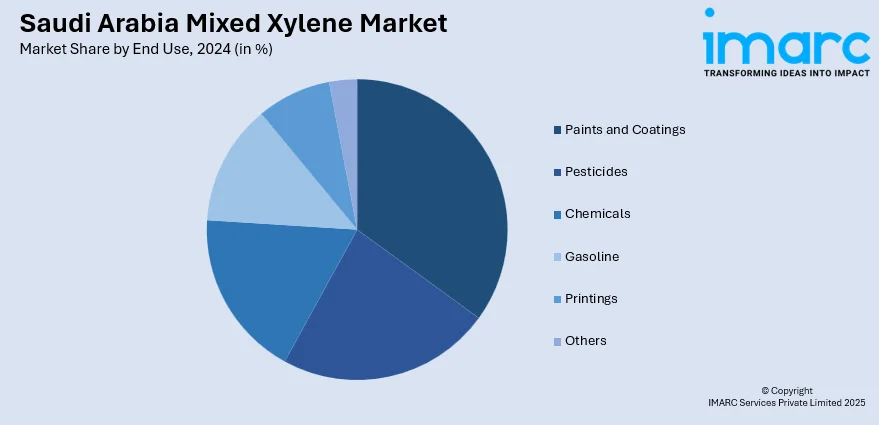
Saudi Arabia Mixed Xylene Market Size, Share, Trends and Forecast by Grade, End Use, and Region, 2025-2033
Saudi Arabia Mixed Xylene Market Overview:
The Saudi Arabia mixed xylene market size reached USD 542.29 Million in 2024. Looking forward, IMARC Group expects the market to reach USD 881.01 Million by 2033, exhibiting a growth rate (CAGR) of 5.54% during 2025-2033. The heightened industrial requirement for xylene derivatives is impelling the growth of the market is Saudi Arabia. This trend, along with the rapid expansion of petrochemical production capacity in the country and Government policies and initiatives, is playing a critical role in expanding the Saudi Arabia mixed xylene market share.
|
Report Attribute
|
Key Statistics
|
|---|---|
|
Base Year
|
2024 |
|
Forecast Years
|
2025-2033
|
|
Historical Years
|
2019-2024
|
| Market Size in 2024 | USD 542.29 Million |
| Market Forecast in 2033 | USD 881.01 Million |
| Market Growth Rate 2025-2033 | 5.54% |
Saudi Arabia Mixed Xylene Market Trends:
Increasing Industrial Demand for Xylene Derivatives
The rising industrial demand for xylene derivatives is impelling the growth of the market is Saudi Arabia. Xylene is mainly utilized in the manufacturing of chemicals, such as terephthalic acid, which is employed in the production of polyester, and isomers like paraxylene, which are essential in the manufacturing of plastic bottles, textiles, and films. As Saudi industries continue to grow, particularly in petrochemicals and textiles, the market for mixed xylene is gradually rising. Producers are continually expanding their capacities to fulfill the growing demand in the textile and packaging industries, which are the primary users of xylene derivatives. The long-term strategy to broaden petrochemical complexes and upgrade the production of chemicals based on xylene is driving the market. This continuous industrial upgradation is guaranteeing a consistent increase in mixed xylene use in the nation. The Saudi Arabia petrochemicals market size is predicted to attain USD 9.0 Billion by 2033, according to the data presented by the IMARC Group.

Expanding Petrochemical Production Capacity
The expansion of petrochemical production capacity is contributing to the Saudi Arabia mixed xylene market growth. Saudi Arabia is making huge investments in developing infrastructure, and new petrochemical units and refineries are constructed to enhance capacity. Mixed xylene is a major by-product in refineries, and its supply is being guaranteed by increasing refining process efficiency. With Saudi Arabia stepping towards further diversification in the economy and higher emphasis on non-oil industries, its development of its petrochemical industry is also presenting new possibilities for blended xylene demand. The Kingdom's Vision 2030 plan that lays strong focus on developing petrochemical and manufacturing industries is further driving the trend. In 2024, Arthur D. Little Middle East principal Hector Casas identified in an interview with Arab News that Saudi Arabian petrochemical capability will double in the space of five years, from a total of some 75 million tons per year to over 140 million tons per year. Through the continuous optimization of refining methods and investment in sophisticated technologies, the Kingdom is improving the production of mixed xylene, thereby satisfying local and foreign market demands.
Government Support for Chemical and Petrochemical Sectors
Government policies and initiatives are playing a critical role in bolstering the market growth. The government is actively supporting the development of the chemical and petrochemical sectors as part of its broader economic diversification plans under Vision 2030. This includes providing incentives for research and development (R&D), infrastructure development, and investments in new technologies. In addition, the government is facilitating favorable regulatory environments for both domestic and foreign investments in the petrochemical sector. These efforts are fostering the expansion of production capacities for xylene, and as a result, mixed xylene is becoming more readily available for a variety of applications. Moreover, the Kingdom’s push to become a leading exporter of chemical products is further driving the demand for mixed xylene, ensuring that the market continues to experience growth driven by governmental support for the industry.
Saudi Arabia Mixed Xylene Market Segmentation:
IMARC Group provides an analysis of the key trends in each segment of the market, along with forecasts at the country and regional levels for 2025-2033. Our report has categorized the market based on grade and end use.
Grade Insights:
- Isomer Grade Mixed Xylene
- Solvent Grade Mixed Xylene
The report has provided a detailed breakup and analysis of the market based on the grade. This includes isomer grade mixed xylene and solvent grade mixed xylene.
End Use Insights:

- Paints and Coatings
- Pesticides
- Chemicals
- Gasoline
- Printings
- Others
A detailed breakup and analysis of the market based on the end use have also been provided in the report. This includes paints and coatings, pesticides, chemicals, gasoline, printings, and others.
Regional Insights:
- Northern and Central Region
- Western Region
- Eastern Region
- Southern Region
The report has also provided a comprehensive analysis of all the major regional markets, which include Northern and Central Region, Western Region, Eastern Region, and Southern Region.
Competitive Landscape:
The market research report has also provided a comprehensive analysis of the competitive landscape. Competitive analysis such as market structure, key player positioning, top winning strategies, competitive dashboard, and company evaluation quadrant has been covered in the report. Also, detailed profiles of all major companies have been provided.
Saudi Arabia Mixed Xylene Market Report Coverage:
| Report Features | Details |
|---|---|
| Base Year of the Analysis | 2024 |
| Historical Period | 2019-2024 |
| Forecast Period | 2025-2033 |
| Units | Million USD |
| Scope of the Report | Exploration of Historical Trends and Market Outlook, Industry Catalysts and Challenges, Segment-Wise Historical and Future Market Assessment:
|
| Grades Covered | Isomer Grade Mixed Xylene, Solvent Grade Mixed Xylene |
| End Uses Covered | Paints and Coatings, Pesticides, Chemicals, Gasoline, Printings, Others |
| Regions Covered | Northern and Central Region, Western Region, Eastern Region, Southern Region |
| Customization Scope | 10% Free Customization |
| Post-Sale Analyst Support | 10-12 Weeks |
| Delivery Format | PDF and Excel through Email (We can also provide the editable version of the report in PPT/Word format on special request) |
Key Questions Answered in This Report:
- How has the Saudi Arabia mixed xylene market performed so far and how will it perform in the coming years?
- What is the breakup of the Saudi Arabia mixed xylene market on the basis of grade?
- What is the breakup of the Saudi Arabia mixed xylene market on the basis of end use
- What is the breakup of the Saudi Arabia mixed xylene market on the basis of region?
- What are the various stages in the value chain of the Saudi Arabia mixed xylene market?
- What are the key driving factors and challenges in the Saudi Arabia mixed xylene market?
- What is the structure of the Saudi Arabia mixed xylene market and who are the key players?
- What is the degree of competition in the Saudi Arabia mixed xylene market?
Key Benefits for Stakeholders:
- IMARC’s industry report offers a comprehensive quantitative analysis of various market segments, historical and current market trends, market forecasts, and dynamics of the Saudi Arabia mixed xylene market from 2019-2033.
- The research report provides the latest information on the market drivers, challenges, and opportunities in the Saudi Arabia mixed xylene market.
- Porter's five forces analysis assist stakeholders in assessing the impact of new entrants, competitive rivalry, supplier power, buyer power, and the threat of substitution. It helps stakeholders to analyze the level of competition within the Saudi Arabia mixed xylene industry and its attractiveness.
- Competitive landscape allows stakeholders to understand their competitive environment and provides an insight into the current positions of key players in the market.
Need more help?
- Speak to our experienced analysts for insights on the current market scenarios.
- Include additional segments and countries to customize the report as per your requirement.
- Gain an unparalleled competitive advantage in your domain by understanding how to utilize the report and positively impacting your operations and revenue.
- For further assistance, please connect with our analysts.
 Request Customization
Request Customization
 Speak to an Analyst
Speak to an Analyst
 Request Brochure
Request Brochure
 Inquire Before Buying
Inquire Before Buying




.webp)




.webp)












